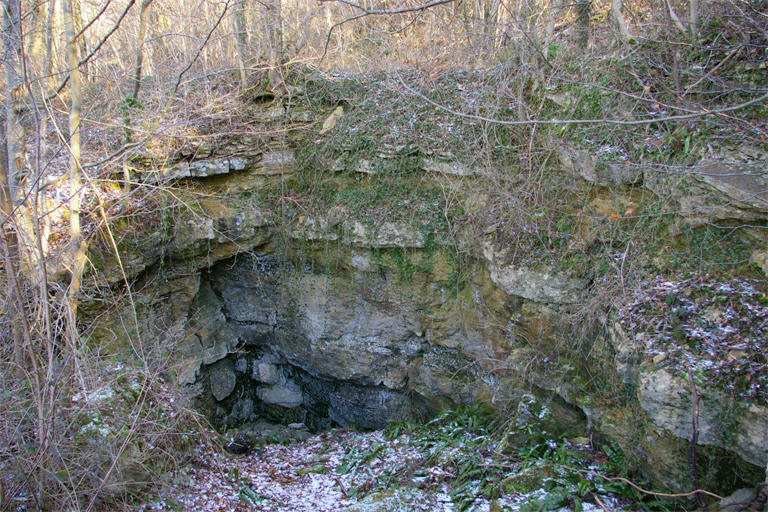
 |
Site 4 Upper Rags/Forest Marble
|
Follow the path around site 3 and then down to site 4, (GPS N 51o23.562' W 002o17.790').
This site has been formed by some of the overlying rocks collapsing into a mine and shows almost a complete section through the rocks that are above the Roof Bed (seen at Site 1). At the top are beds of the Forest Marble showing very clearly the cross bedded nature of this formation with a prominent band of brown clay at its base. The rest of the face shows a series of rocks forming part of the Upper Rags a name derived from the quarryman’s description of these rocks; ‘Ragstones’, so called because of their variable nature and general unsuitability as building stone. At the base is a white oolite; this is not the Bath Oolite but the oolite seen above the Roof Bed at Site 1 and will be examined in more detail at Sites 5 and 7. The clay band at the base of the Forest Marble is a thin representative of the Bradford Clay that forms much thicker deposits around Bradford-on-Avon and from which exceptionally well preserved fossils have been obtained. The most famous of these is a crinoid Apiocrinus. Although crinoids have the appearance of plants and are sometimes called ‘sea lilies’ they are in fact invertebrates, being related to sea urchins and starfish. They are common in seas today. The steep path that descends from this site passes almost immediately through the Bradford Clay and disarticulated parts of Apiocrinus and brachiopods characteristic of the Bradford Clay can be found in the weathered scree. Please do not dig out the clay band at the site face as this could result in the face becoming unstable. The Bradford Clay will be seen again at Site 7.
If you continue for a short way on the steep path down the hillside, (which can be slippery and difficult in wet weather) you will reach a block of limestone on the left hand side of the path. Block of Limestone below Site 4 Here the junction between some of the lower beds of the Upper Rags that were seen in the face
at Site 4 can be examined in detail. At the base is a white oolite. This is overlain by a harder brown rock in which there are
conspicuous holes that have resulted from weathering of the rock giving it a honeycomb appearance. On some surfaces of this, fossils can be seen,
amongst which the edges of corrugated bivalve (Pecten) shells are conspicuous. Above this is a shelly oolitic band showing honeycomb
weathering.
Return to Site 3, rejoin the path and walk back to the Folly. Go through the gate opposite the Folly and down the steps to the lower level. Site 5 is on your right, (GPS N 51o23.602' W002o17.813'). |

Site 4
|